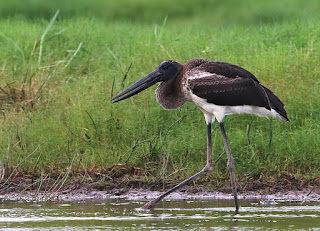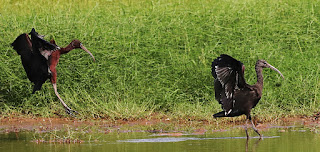Great Bowerbird about to swallow one of fast-diminishing sweet figs from fruitful and recently fruit-full tree at entry to Townsville Town Common Conservation Park early this morning.
Earlier in week of scattered showers and some (but not enough) heavy rain found Galah tucking into morning greens alongside road to the Common.
Brief chat today with pair of young Magpies, but above image came during a previous walk across dry section (looking in vain for button-quail).
Continuing efforts to sort Torresian Crows from Australian Ravens, caught crow at Pallarenda showing diagnostic purple sheen in morning sunlight on breast.
Another happy sunlit shot (though better would have been natural perch), Pheasant Coucal beside road through the Common.
And Red-tailed Black Cockatoo launches from low during another recent early morning outing.
Saturday, January 27, 2018
Tuesday, January 23, 2018
All's well after wee flap over flapping junior Jabiru
Jabiru junior shows robust health morning after alarming visitor with much head tossing and wing flapping interpreted as throat obstruction but more likely demands for food from parents.
Last pools at best viewing areas remain wetter than same time last year. But without rain by end of month mud will show through almost everywhere.
No more images of Jabiru (Black-necked Stork) senior jabbing into the water for slippery catches.
No more Black-fronted Dotterel immature poking about at edge of water.
And fewer close views of Brolgas flying in to forage through grasses and, less often, pools.
And no more chances to stand relatively close to Royal Spoonbills, trying combinations of cameras and lenses (top down: 1D+600; 1D+1.4x+600; 7D+1.4+600= 1344mm! Conclusion: kiss - keep it simple, stupid - is best).
Last pools at best viewing areas remain wetter than same time last year. But without rain by end of month mud will show through almost everywhere.
No more images of Jabiru (Black-necked Stork) senior jabbing into the water for slippery catches.
No more Black-fronted Dotterel immature poking about at edge of water.
And fewer close views of Brolgas flying in to forage through grasses and, less often, pools.
And no more chances to stand relatively close to Royal Spoonbills, trying combinations of cameras and lenses (top down: 1D+600; 1D+1.4x+600; 7D+1.4+600= 1344mm! Conclusion: kiss - keep it simple, stupid - is best).
Saturday, January 20, 2018
Pipit swims into view after dry Aussie crawl
Bit of dry Aussie crawl across baked mud at Melaleuca viewing area today brought Australian Pipit closer than commonly - for a few frames.
Pity, bird didn't offer 'that' perfect pose. Then, better pose, but greater distance.
Too much greenery to allow crawl up on Horsfields Bushlark. The species can, however, be surprisingly tolerant of people walking patiently toward them. Not at all tolerant, and thus unphotographed, pair of Brown Quail and a Red-backed Buttonquail unseen till flushed from long couchgrass nearby.
If only their behaviour matched that of Owlet Nightjar. Haven't got daytime look at species in the Town Common. Got lucky early in the week at western edge of Townsville while having casual look for honeyeaters near bottom of highway climb up local range. Spotted huge scar 20-metres up towering gum - with curious grey blob.
Which resolved through binoculars into alert nightjar. No way down 20m drop off highway and 40-50m across to gum, so lucky find could not become lucky sharp image.
If only nightjars thronged like Rainbow Lorikeets. In this case, to rose gums flowering at eastern fence edge of the Town Common. Plenty of action again today: bird above feeding on Thursday morning.
No thronging for Eastern Koels, but above female and a male tucked into a mixture of native figs beside the entry gate this morning.
And to polish things off, immature Pacific Baza about to end several minutes of carrying big colourful caterpillar and polish it off with one quick swallow.
Pity, bird didn't offer 'that' perfect pose. Then, better pose, but greater distance.
Too much greenery to allow crawl up on Horsfields Bushlark. The species can, however, be surprisingly tolerant of people walking patiently toward them. Not at all tolerant, and thus unphotographed, pair of Brown Quail and a Red-backed Buttonquail unseen till flushed from long couchgrass nearby.
If only their behaviour matched that of Owlet Nightjar. Haven't got daytime look at species in the Town Common. Got lucky early in the week at western edge of Townsville while having casual look for honeyeaters near bottom of highway climb up local range. Spotted huge scar 20-metres up towering gum - with curious grey blob.
Which resolved through binoculars into alert nightjar. No way down 20m drop off highway and 40-50m across to gum, so lucky find could not become lucky sharp image.
If only nightjars thronged like Rainbow Lorikeets. In this case, to rose gums flowering at eastern fence edge of the Town Common. Plenty of action again today: bird above feeding on Thursday morning.
No thronging for Eastern Koels, but above female and a male tucked into a mixture of native figs beside the entry gate this morning.
And to polish things off, immature Pacific Baza about to end several minutes of carrying big colourful caterpillar and polish it off with one quick swallow.
Saturday, January 13, 2018
Two glossy legs good, four grossy legs bad
First quartet displayed uniform breeding plumage.
Later two offer more contrast, with one bird less colourful.
Less attractive - but lovable enough as curly-tailed piglets - feral pigs.
Pig count topped bird count at Melaleuca one morning last week. Perhaps if the damage they wreak came close to Parks and Wildlife's state HQ more resources would be found to deal with them.
Sunday, January 7, 2018
Booboo prompts more questions of identity
Big booboo last post - since mostly corrected, but clue left as challenge. Error came from initial assumption of bird's identity. Mistake then blocked any chance of self-correction. Here's a look at recent examples of ID problems, all from within limited confines of Townsville Common Conservation Park, starting with one of most frequent, Collared Sparrowhawk (juvenile above and below: but barred adults also look alike ) versus Brown Goshawk.
Sparrowhawks stare, Goshawks glower. Easy! Except Sparrowhawks often glower a bit. And their tails (square tipped with notch, against rounded unnotched) fold inconclusively in the field. And their very long middle toes and thin legs look less impressively different in the field than in the field guides. Ditto colour, head, bill, and, specially in the north, size differences. So, no surprise if Collared Sparrowhawk ID should be challenged.
Less contentious, though commonly mislisted as Grey Shrike-thrush, Little Shrike-thrush. (above and below), previously called Rufous Shrike-thrush. Above image closely matches what birders expect to see.
Same bird taken a day earlier in less sunlight shows why Little becomes identified as Grey, which is larger, lighter grey, sounds different, and in North Queensland prefers higher and drier inland woodland.
No question about Australasian Pipit. Until it's identified as Anthus australis australis. Because across the Top (of Australia) there's another subspecies, Anthus australis rogersi, which stands very upright, is more heavily streaked down the breast, is said to have a shorter tail and longer legs than the three other Pipit ssp.
It seems rogersi may have snuck southeast hundreds of kilometres down the NQ coast without drawing field guide attention to itself. Problems: every Pipit locally stands very upright, but often without extra heavy streaking. Tail and leg lengths difficult to measure without bird in hand.
Here's to further challenges (and fewer booboos) in 2018.
Sparrowhawks stare, Goshawks glower. Easy! Except Sparrowhawks often glower a bit. And their tails (square tipped with notch, against rounded unnotched) fold inconclusively in the field. And their very long middle toes and thin legs look less impressively different in the field than in the field guides. Ditto colour, head, bill, and, specially in the north, size differences. So, no surprise if Collared Sparrowhawk ID should be challenged.
Less contentious, though commonly mislisted as Grey Shrike-thrush, Little Shrike-thrush. (above and below), previously called Rufous Shrike-thrush. Above image closely matches what birders expect to see.
Same bird taken a day earlier in less sunlight shows why Little becomes identified as Grey, which is larger, lighter grey, sounds different, and in North Queensland prefers higher and drier inland woodland.
No question about Australasian Pipit. Until it's identified as Anthus australis australis. Because across the Top (of Australia) there's another subspecies, Anthus australis rogersi, which stands very upright, is more heavily streaked down the breast, is said to have a shorter tail and longer legs than the three other Pipit ssp.
It seems rogersi may have snuck southeast hundreds of kilometres down the NQ coast without drawing field guide attention to itself. Problems: every Pipit locally stands very upright, but often without extra heavy streaking. Tail and leg lengths difficult to measure without bird in hand.
Here's to further challenges (and fewer booboos) in 2018.
Subscribe to:
Comments (Atom)
Lament for southern Black-throated Finches
Hollow logs for at risk birdies? Nature's nest boxes if you please Oh, such a clever wheeze So gather in twos and threes? Hundreds you w...

-
Hollow logs for at risk birdies? Nature's nest boxes if you please Oh, such a clever wheeze So gather in twos and threes? Hundreds you w...
-
White-faced Heron stands up and begs picture be taken at Tyto. The birds can develop some trust in people, but I've never found any aro...
-
Who gives way on footbridge, Yellow-spotted Monitor or unspotted bird watcher? Naturally, dinkum locals have right-of-way. I step aside, Spo...










































